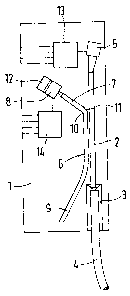Some of the information on this Web page has been provided by external sources. The Government of Canada is not responsible for the accuracy, reliability or currency of the information supplied by external sources. Users wishing to rely upon this information should consult directly with the source of the information. Content provided by external sources is not subject to official languages, privacy and accessibility requirements.
Any discrepancies in the text and image of the Claims and Abstract are due to differing posting times. Text of the Claims and Abstract are posted:
| (12) Patent Application: | (11) CA 2158722 |
|---|---|
| (54) English Title: | OPTICAL COUPLING ARRANGEMENT |
| (54) French Title: | DISPOSITIF DE COUPLAGE OPTIQUE |
| Status: | Deemed Abandoned and Beyond the Period of Reinstatement - Pending Response to Notice of Disregarded Communication |
| (51) International Patent Classification (IPC): |
|
|---|---|
| (72) Inventors : |
|
| (73) Owners : |
|
| (71) Applicants : |
|
| (74) Agent: | ROBIC AGENCE PI S.E.C./ROBIC IP AGENCY LP |
| (74) Associate agent: | |
| (45) Issued: | |
| (22) Filed Date: | 1995-09-20 |
| (41) Open to Public Inspection: | 1996-03-22 |
| Examination requested: | 2001-05-03 |
| Availability of licence: | N/A |
| Dedicated to the Public: | N/A |
| (25) Language of filing: | English |
| Patent Cooperation Treaty (PCT): | No |
|---|
| (30) Application Priority Data: | ||||||
|---|---|---|---|---|---|---|
|
An optical duplexer, configured as a directional
coupler, is integrated into an optical coupling
arrangement with a fiber optic pigtail, constructed in
planar-optical hybrid technology on a substrate (1). To
reduce the required surface area and decrease optical
cross talk, the branch of the directional coupler
(waveguide 6, branch 7) is sharply bent. The bend is
equipped with a reflecting mirror (11) integrated
opposite the inner edge (10) of the bend. Furthermore,
the waveguiding end of the bent branch (7) is equipped
with a cylindrical lens. A laser diode (8) is located
before this, and a photodiode (5) is located before the
angled end of the straight-line integrated waveguide (2).
Note: Claims are shown in the official language in which they were submitted.
Note: Descriptions are shown in the official language in which they were submitted.

2024-08-01:As part of the Next Generation Patents (NGP) transition, the Canadian Patents Database (CPD) now contains a more detailed Event History, which replicates the Event Log of our new back-office solution.
Please note that "Inactive:" events refers to events no longer in use in our new back-office solution.
For a clearer understanding of the status of the application/patent presented on this page, the site Disclaimer , as well as the definitions for Patent , Event History , Maintenance Fee and Payment History should be consulted.
| Description | Date |
|---|---|
| Inactive: IPC from MCD | 2006-03-11 |
| Inactive: IPC from MCD | 2006-03-11 |
| Inactive: IPC from MCD | 2006-03-11 |
| Application Not Reinstated by Deadline | 2003-07-11 |
| Inactive: Dead - Final fee not paid | 2003-07-11 |
| Deemed Abandoned - Failure to Respond to Maintenance Fee Notice | 2002-09-20 |
| Deemed Abandoned - Conditions for Grant Determined Not Compliant | 2002-07-11 |
| Notice of Allowance is Issued | 2002-01-11 |
| Notice of Allowance is Issued | 2002-01-11 |
| Letter Sent | 2002-01-11 |
| Inactive: Approved for allowance (AFA) | 2001-12-27 |
| Letter Sent | 2001-06-21 |
| Inactive: Status info is complete as of Log entry date | 2001-06-19 |
| Inactive: Application prosecuted on TS as of Log entry date | 2001-06-19 |
| Amendment Received - Voluntary Amendment | 2001-05-15 |
| All Requirements for Examination Determined Compliant | 2001-05-03 |
| Request for Examination Requirements Determined Compliant | 2001-05-03 |
| Application Published (Open to Public Inspection) | 1996-03-22 |
| Abandonment Date | Reason | Reinstatement Date |
|---|---|---|
| 2002-09-20 | ||
| 2002-07-11 |
The last payment was received on 2001-08-29
Note : If the full payment has not been received on or before the date indicated, a further fee may be required which may be one of the following
Please refer to the CIPO Patent Fees web page to see all current fee amounts.
| Fee Type | Anniversary Year | Due Date | Paid Date |
|---|---|---|---|
| MF (application, 2nd anniv.) - standard | 02 | 1997-09-22 | 1997-08-22 |
| MF (application, 3rd anniv.) - standard | 03 | 1998-09-21 | 1998-08-18 |
| MF (application, 4th anniv.) - standard | 04 | 1999-09-20 | 1999-08-23 |
| MF (application, 5th anniv.) - standard | 05 | 2000-09-20 | 2000-08-24 |
| Request for examination - standard | 2001-05-03 | ||
| MF (application, 6th anniv.) - standard | 06 | 2001-09-20 | 2001-08-29 |
Note: Records showing the ownership history in alphabetical order.
| Current Owners on Record |
|---|
| ALCATEL N.V. |
| Past Owners on Record |
|---|
| HANS-PETER MAYER |
| KLAUS WUNSTEL |
| OLAF HILDEBRAND |
| WALTER HOFFMANN |
| WERNER REHM |